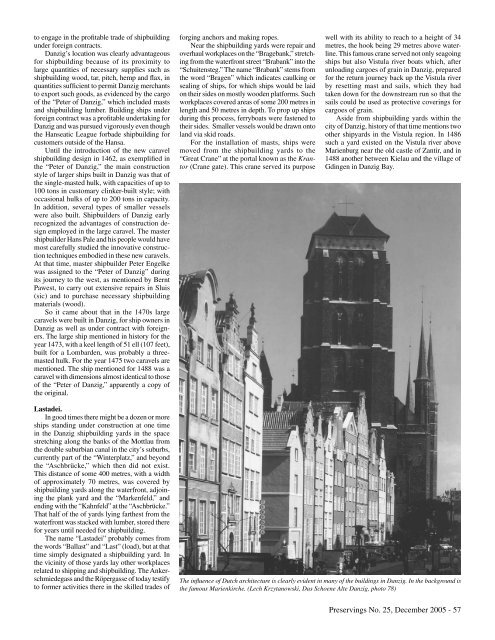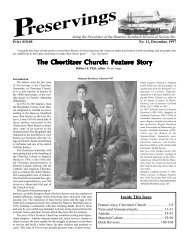Preservings $20 No. 25, December, 2005 - Plett Foundation
Preservings $20 No. 25, December, 2005 - Plett Foundation
Preservings $20 No. 25, December, 2005 - Plett Foundation
Create successful ePaper yourself
Turn your PDF publications into a flip-book with our unique Google optimized e-Paper software.
to engage in the profitable trade of shipbuilding<br />
under foreign contracts.<br />
Danzig’s location was clearly advantageous<br />
for shipbuilding because of its proximity to<br />
large quantities of necessary supplies such as<br />
shipbuilding wood, tar, pitch, hemp and flax, in<br />
quantities sufficient to permit Danzig merchants<br />
to export such goods, as evidenced by the cargo<br />
of the “Peter of Danzig,” which included masts<br />
and shipbuilding lumber. Building ships under<br />
foreign contract was a profitable undertaking for<br />
Danzig and was pursued vigorously even though<br />
the Hanseatic League forbade shipbuilding for<br />
customers outside of the Hansa.<br />
Until the introduction of the new caravel<br />
shipbuilding design in 1462, as exemplified in<br />
the “Peter of Danzig,” the main construction<br />
style of larger ships built in Danzig was that of<br />
the single-masted hulk, with capacities of up to<br />
100 tons in customary clinker-built style; with<br />
occasional hulks of up to 200 tons in capacity.<br />
In addition, several types of smaller vessels<br />
were also built. Shipbuilders of Danzig early<br />
recognized the advantages of construction design<br />
employed in the large caravel. The master<br />
shipbuilder Hans Pale and his people would have<br />
most carefully studied the innovative construction<br />
techniques embodied in these new caravels.<br />
At that time, master shipbuilder Peter Engelke<br />
was assigned to the “Peter of Danzig” during<br />
its journey to the west, as mentioned by Bernt<br />
Pawest, to carry out extensive repairs in Sluis<br />
(sic) and to purchase necessary shipbuilding<br />
materials (wood).<br />
So it came about that in the 1470s large<br />
caravels were built in Danzig, for ship owners in<br />
Danzig as well as under contract with foreigners.<br />
The large ship mentioned in history for the<br />
year 1473, with a keel length of 51 ell (107 feet),<br />
built for a Lombarden, was probably a threemasted<br />
hulk. For the year 1475 two caravels are<br />
mentioned. The ship mentioned for 1488 was a<br />
caravel with dimensions almost identical to those<br />
of the “Peter of Danzig,” apparently a copy of<br />
the original.<br />
Lastadei.<br />
In good times there might be a dozen or more<br />
ships standing under construction at one time<br />
in the Danzig shipbuilding yards in the space<br />
stretching along the banks of the Mottlau from<br />
the double suburbian canal in the city’s suburbs,<br />
currently part of the “Winterplatz,” and beyond<br />
the “Aschbrücke,” which then did not exist.<br />
This distance of some 400 metres, with a width<br />
of approximately 70 metres, was covered by<br />
shipbuilding yards along the waterfront, adjoining<br />
the plank yard and the “Markenfeld,” and<br />
ending with the “Kahnfeld” at the “Aschbrücke.”<br />
That half of the of yards lying farthest from the<br />
waterfront was stacked with lumber, stored there<br />
for years until needed for shipbuilding.<br />
The name “Lastadei” probably comes from<br />
the words “Ballast” and “Last” (load), but at that<br />
time simply designated a shipbuilding yard. In<br />
the vicinity of those yards lay other workplaces<br />
related to shipping and shipbuilding. The Ankerschmiedegass<br />
and the Röpergasse of today testify<br />
to former activities there in the skilled trades of<br />
forging anchors and making ropes.<br />
Near the shipbuilding yards were repair and<br />
overhaul workplaces on the “Bragebank,” stretching<br />
from the waterfront street “Brabank” into the<br />
“Schuitensteg.” The name “Brabank” stems from<br />
the word “Bragen” which indicates caulking or<br />
sealing of ships, for which ships would be laid<br />
on their sides on mostly wooden platforms. Such<br />
workplaces covered areas of some 200 metres in<br />
length and 50 metres in depth. To prop up ships<br />
during this process, ferryboats were fastened to<br />
their sides. Smaller vessels would be drawn onto<br />
land via skid roads.<br />
For the installation of masts, ships were<br />
moved from the shipbuilding yards to the<br />
“Great Crane” at the portal known as the Krantor<br />
(Crane gate). This crane served its purpose<br />
well with its ability to reach to a height of 34<br />
metres, the hook being 29 metres above waterline.<br />
This famous crane served not only seagoing<br />
ships but also Vistula river boats which, after<br />
unloading cargoes of grain in Danzig, prepared<br />
for the return journey back up the Vistula river<br />
by resetting mast and sails, which they had<br />
taken down for the downstream run so that the<br />
sails could be used as protective coverings for<br />
cargoes of grain.<br />
Aside from shipbuilding yards within the<br />
city of Danzig, history of that time mentions two<br />
other shipyards in the Vistula region. In 1486<br />
such a yard existed on the Vistula river above<br />
Marienburg near the old castle of Zantir, and in<br />
1488 another between Kielau and the village of<br />
Gdingen in Danzig Bay.<br />
The influence of Dutch architecture is clearly evident in many of the buildings in Danzig. In the background is<br />
the famous Marienkirche. (Lech Krzytanowski, Das Schoene Alte Danzig, photo 78)<br />
<strong>Preservings</strong> <strong>No</strong>. <strong>25</strong>, <strong>December</strong> <strong>2005</strong> - 57

















